The Large Hadron Collider - CERN
I have always been struck by the CERN project, but sincerely the first time I've investigated so much about what is a particle accelerator? What is CERN? What is the Large Hadron Collider?. I used several research sources, in web pages and documentaries that I will insert at the end of this publication. For a better understanding I have placed several GIFs and images so that they can appreciate and have a greater imagination of how things happen.
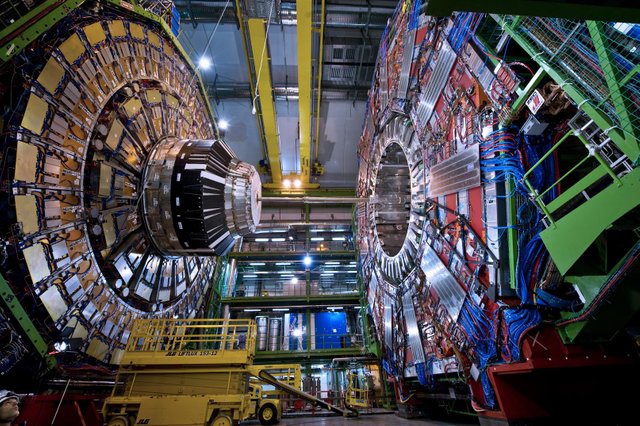
Particle accelerators began to develop in the late 1920s and early 1930s. Many of them were circular and used a combination of electric and magnetic fields to push the particles. The main function of these accelerators was to decipher that matter was composed, when they discovered that the atoms were formed by smaller subatomic particles, began a race to understand the nature of these particles.
Let's understand ...
What is a particle accelerator?
As the name implies, it is responsible for increasing the speed of beams of charged particles to then make them collide with other particles, in this way new particles are created.

There are two types of accelerators:
Linear
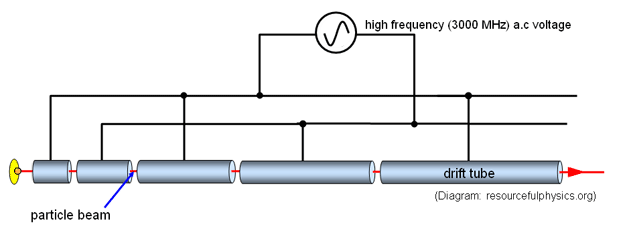
Also called LINAC, is a type of accelerator that uses a set of plates or tubes located in line to which an alternative electric field is applied, accelerating subatomic particles. They are used mostly in the medical or health industry, to treat cancerous tumors and diseases.
Circulars
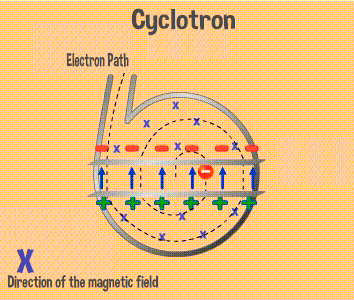
The first accelerators of this type were the cyclotron, it was designed to accelerate particles with charges. A charged particle is accelerated with a potential difference, a constant magnetic field rotates it, then the polarity of potential is changed to accelerate the particle in the other direction. So on, gaining speed on every lap.
The Large Hadron Collider
This large collider is located in the facilities of CERN, was founded in 1954 as an international center for Nuclear Physics. Today, it is a laboratory of particle physics that counts with scientists from all over the world who seek to understand the birth of our universe. The large Hadron Collider or its acronym (LHC) was built underground at a great depth in Geneva, Switzerland.
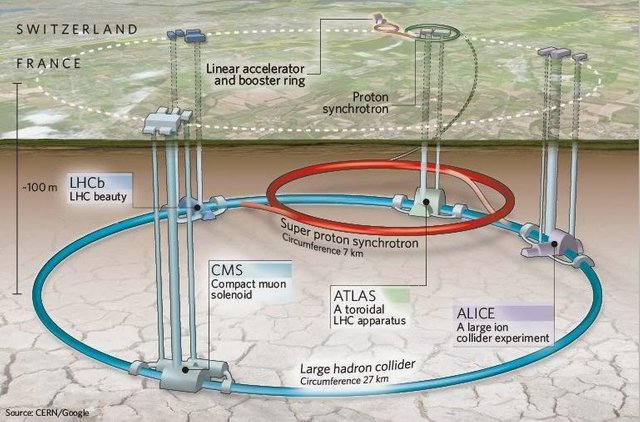
Functioning
At a controlled rate with great precision the hydrogen atoms of a cylinder are introduced into the source of the linear accelerator (LINAC 2) where the electrons are removed, obtaining the hydrogen nuclei. These nuclei are in fact protons and have positive electric charge, so they can be accelerated by an electric field.
The protons begin their journey, when the proton pack leaves the area of the Linac 2 its speed will be the 3rd part of the speed of light, it will be about to enter a Booster.
To maximize the speed the package is divided into four, one for each ring of the Booster. Its circumference is 157 meters. In order to accelerate these packages they are given multiple turns, at this point the electric field is pulsed. This means that it is applied in a similar way as when a child swings. It is pushed every time it reaches a certain point.

Magnets exert protons, a force perpendicular to their movement. Extremely powerful magnets are used to bend the proton beam guiding it along the circumference.
The Booster accelerates the protons to 91.6% of the speed of light and brings it closer to each other. Making the package more and more compact.
After recombining the packages of the 4 rings, the resulting package is directed towards the proton synchrotron. The proton synchroton measures 628m in circumference, the protons circulating inside it 1.2 seconds until reaching a speed greater than 99.9% of the speed of light. This is where the transition point is reached. A point at which the energy that the pulsating electric field provides protons can no longer be translated into an increase in speed, because protons are already measured at almost the speed of light.
Instead, the added energy manifests itself in an increase in the mass of the protons. In short, since protons can not go faster they become heavier, the microscopic kinetic energy of each proton is measured in a unit called Electron Voltio.
So far the energy of each proton has increased to 25 GeV (Giga-electronvolt), that is, 25 billion Electron-volt. Protons are now 25 times heavier than when they were still.
Now the proton packages are channeled to the 4th phase, the super proton synchrotron (SPS). It is a huge ring of 7km in circumference specially designed to accept protons at this energy and increase it up to 450 GeV (Giga-electronvolt), speed that is necessary to be launched at the large hadron collider (LHC), has a circumference of 27km. Inside there are two tubes in which the vacuum has been made (More empty than outer space), which is why proton beams circulate in the opposite direction. They use extremely sophisticated devices to synchronize the incoming packets with those already in circulation.
A vacuum tube injects protons that go clockwise and other protons that will do so in the opposite direction.
The beams cross inside the cores of 4 main detectors, where they are collided. The energy of the collision is double of each of the opposite protons, which are the residues of these collisions that are recorded in the detectors.
The SPS injects protons for half an hour, at the end there are 2808 packages. During this time the LHC is still providing more energy to the protons whose speed is so close to that of the light that they give more than 11 thousand laps per second along the 27km ring. In each round its energy increases slightly, with the LHC running at full capacity at the end of this process each proton will have an energy of 6.5 TeV (Tera-electronvolt). It will be 7 thousand times heavier than when it is at rest.

The magnetic field necessary to maintain the curved beams inside the ring is so great that it is necessary that a current of 12,000 amperes circulate through its electric magnets. This is achieved by making the temperature of the LHC as low as that of the sidereal space.
Now the protons are ready to collide. Inside the detectors, a magnet guides them until they crash. Working at 100% the total energy increases the temperature to 10 thousand times higher than in the core of the Sun. The two protons that collide in the LHC will be 13 TeV (Tera-Electronvolt) which will reproduce a state similar to those that occurred at the time of the Big Bang.

The traces of the particles generated in these collisions are analyzed in computers connected to the detectors. With these processes it is expected that a future we understand better the birth, evolution and laws that our universe has.

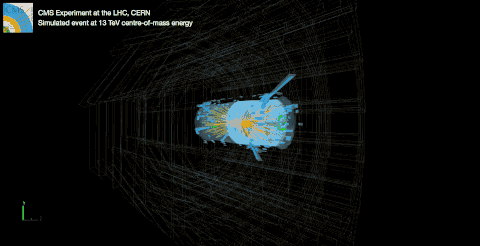
I found a very realistic animation of the Large Hadron Collider process
Animation
I have made this summary especially for the Steemians group that will be attending the Meetup organized by the Science team @steemstem, which will take place at the CERN facilities. I hope that with this information they have an additional knowledge of what they already know.
Greetings friends!
STEEMSTEM ON!
Sources:
Accelerator Particles - sc.ehu.es
Accelerator Particless - Wikipedia
Linear Accelerator - Wikipedia
Accelerator Particles - lhc.closer.es
Operation of the LHC
CERN and the accelerators
Particle accelerator

This is a nice summary. I don't know whether this will be useful to people. I leave them comment on that ^^
I would however update the information you provide. There is a bunch of inaccuracies and it looks that your sources are slightly outdated.
For instance, 1 GeV is 1 billion eV, not 1 million eV (that is a MeV). The LHC beams are accelerated to 6.5 TeV, not 7 TeV and the collision energy is thus 13 TeV and not 14. Moreover, the energy varied with time. On the other hand, we say electron-volt and not Electron Voltio. There are more than 4 detectors at the LHC (although 4 main ones). The number of magnet inside the LHC is much more than 1. And so on.
I recommend to open a recent webpage (or better, LHC thesis), if you want to find more up to date information. This being said, your post is very nice, I repeat :)
Many thanks. I am very happy that you like it, I will follow your corrections and I will edit the post to make the information more accurate, maybe as you say the source was a bit outdated.
Again, thanks for your corrections. Greetings friend.
In search of the "particle of God" ... very interesting publication dear friend.
Correct the Particle of God, thank you I'm glad you liked it.
Actually, there is no particle of god. There is a Higgs boson and that's it. The rest is a matter of the media who promoted that stupid name that physicists hate...
I congratulate @oscarcc89, you for giving us, as always quality information, greetings
Aún cuando debas actualizar detalles técnicos, el Acelerador de particulas es un tema fasinante, quizas ya estemos en la era de star gate y no lo sabemos. Saludos @oscarcc89